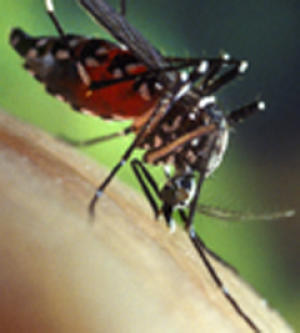|

由蚊子传播的病毒疾病如西尼罗河热、革登热、基孔肯雅热等在世界各地迅速传播,弗吉尼亚理工大学的科学家们正在研究蚊子的免疫系统及病原体是如何克服免疫系统并传染给人类和其他动物宿主。
几乎在世界的每一个地区,人类和动物正经历着由病毒感染的蚊子叮咬所致的高水平的发病率和死亡率。已有超过100种由吸血节肢动物如蚊子传播的病毒与人类或动物的疾病有关。
2种尤其猖獗的是黄热病蚊子(埃及伊蚊)和亚洲虎蚊(白纹伊蚊),这2者很容易辨别,因为它们有条纹状的图案。尽管原产于非洲和亚洲,这些蚊子可以通过搭乘旧轮胎等传播到西方国家。
弗吉尼亚理工大学的研究人员最近在库蚊中发现了一种新型的抗病毒途径。Kevin Myles和Zach Adelman在本月的PLoS Pathogens期刊上发表了他们的研究结果。
"我们之前的研究表明,在库蚊中存在由siRNAs指导的抗病毒反应。然而,我们这里展示的是另一类源自病毒的小RNA,它呈现出很多与piRNAs相似的特性,"他们解释道。Myles和Adelman及其同事使用一种被称为下一代测序的技术帮助了他们的发现。
新发现的抗病毒途径似乎发挥着比先前描述的siRNA途径更宽泛的作用,显示出其为强大的免疫系统。因此,理解病毒如何绕开蚊子的双重抗病毒反应对于科学家来说是越来越有趣的挑战。
"在由蚊子传播病原体的情况下,我们的健康取决于蚊子的免疫反应,因为它确实能对我们自身的免疫反应有用,但对于蚊子的免疫系统我们了解的还出奇的少,"Males说。(生物谷bioon.com)
Production of Virus-Derived Ping-Pong-Dependent piRNA-like Small RNAs in the Mosquito Soma
Elaine M. Morazzani, Michael R. Wiley, Marta G. Murreddu, Zach N. Adelman, Kevin M. Myles.
Abstract: The natural maintenance cycles of many mosquito-borne pathogens require establishment of persistent non-lethal infections in the invertebrate host. The mechanism by which this occurs is not well understood, but we have previously shown that an antiviral response directed by small interfering RNAs (siRNAs) is important in modulating the pathogenesis of alphavirus infections in the mosquito. However, we report here that infection of mosquitoes with an alphavirus also triggers the production of another class of virus-derived small RNAs that exhibit many similarities to ping-pong-dependent piwi-interacting RNAs (piRNAs). However, unlike ping-pong-dependent piRNAs that have been described previously from repetitive elements or piRNA clusters, our work suggests production in the soma. We also present evidence that suggests virus-derived piRNA-like small RNAs are capable of modulating the pathogenesis of alphavirus infections in dicer-2 null mutant mosquito cell lines defective in viral siRNA production. Overall, our results suggest that a non-canonical piRNA pathway is present in the soma of vector mosquitoes and may be acting redundantly to the siRNA pathway to target alphavirus replication.
|

